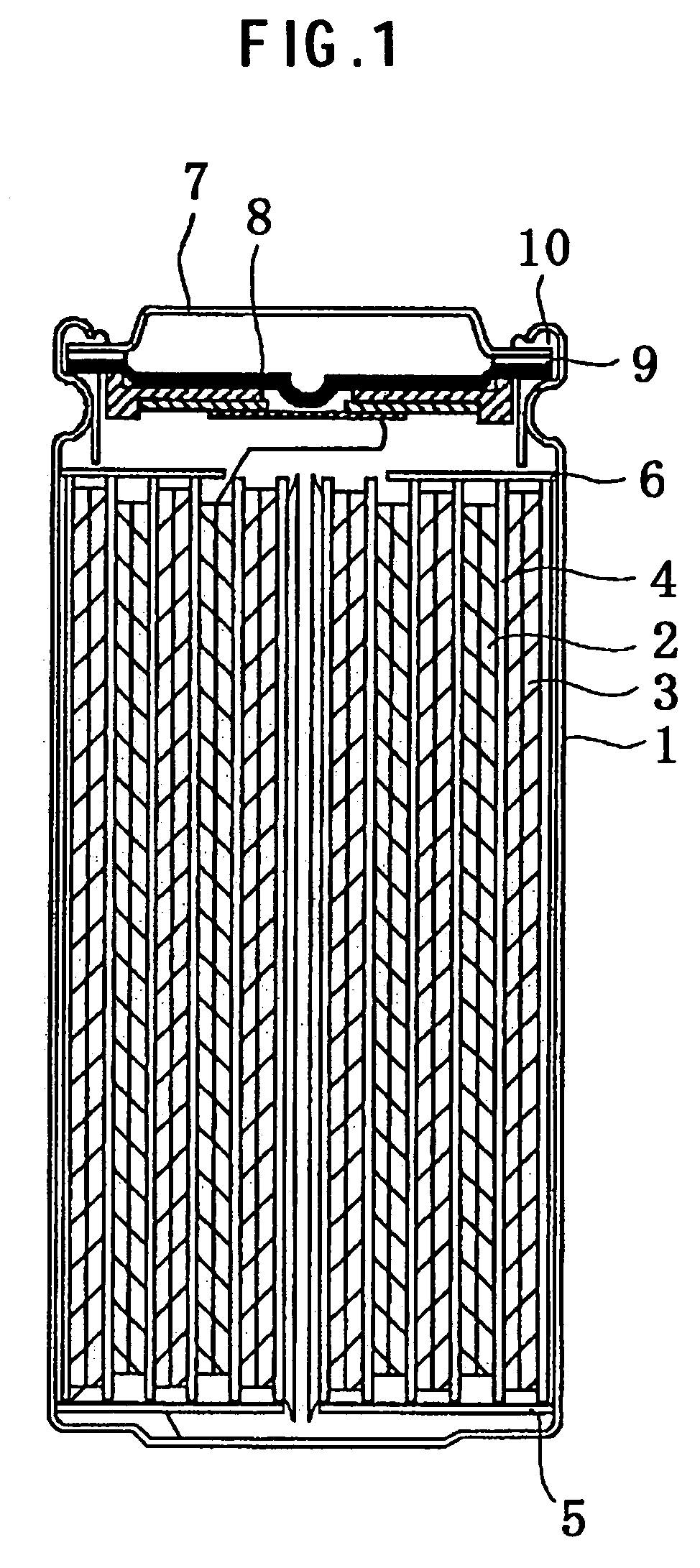Cathode active material and non-aqueous electrolyte secondary battery
a technology of active materials and secondary batteries, applied in the direction of positive electrodes, cell components, electrochemical generators, etc., can solve the problems of large power consumption, marked voltage drop, poor cycle characteristics, etc., and achieve excellent cycle characteristics and low-temperature heavy load characteristics
- Summary
- Abstract
- Description
- Claims
- Application Information
AI Technical Summary
Benefits of technology
Problems solved by technology
Method used
Image
Examples
example 1
Synthesis of Second Cathode Active Material:
[0050]Commercially available lithium hydroxide, nickel hydroxide, cobalt hydroxide, and manganese hydroxide were mixed so that the amounts of lithium, nickel, cobalt, and manganese became 1.05, 0.85, 0.10, and 0.05, respectively, in terms of molar ratio, and calcined at 900° C. in an oxygen gas stream to prepare powder lithium composite oxide (second cathode active material) represented by a general formula: Li1.05Ni0.85Co0.10Mn0.05O2. This lithium composite oxide was subjected to measurement of X-ray diffractometry. As a result, it has been confirmed that the lithium composite oxide is a substance having a structure substantially similar to that of LiNiO2. In the peaks observed, there was not any peak other than the peaks derived from LiNiO2, which confirmed that the lithium composite oxide is a substance of a single layer comprising a solid solution of cobalt and manganese formed at the site of nickel.
Synthesis of First Cathode Active Ma...
example 2
[0063]A non-aqueous electrolyte secondary battery was obtained in substantially the same manner as in Example 1 except that commercially available lithium hydroxide, nickel hydroxide, cobalt hydroxide, and manganese hydroxide were mixed so that the amounts of lithium, nickel, cobalt, and manganese became 1.05, 0.30, 0.65, and 0.05, respectively, in terms of molar ratio. Subsequently, (1) an initial capacity, (2) an initial charge / discharge efficiency, (3) a capacity retaining ratio after the 150th cycle, and (4) the voltage drop during the output at 20 W at 0° C. were determined in the same manner as in Example 1.
example 3
[0064]A non-aqueous electrolyte secondary battery was obtained in substantially the same manner as in Example 1 except that commercially available lithium hydroxide, nickel hydroxide, cobalt hydroxide, and manganese hydroxide were mixed so that the amounts of lithium, nickel, cobalt, and manganese became 1.05, 0.60, 0.00, and 0.40, respectively, in terms of molar ratio. Subsequently, (1) an initial capacity, (2) an initial charge / discharge efficiency, (3) a capacity retaining ratio after the 150th cycle, and (4) the voltage drop during the output at 20 W at 0° C. were determined in the same manner as in Example 1.
PUM
| Property | Measurement | Unit |
|---|---|---|
| specific surface area | aaaaa | aaaaa |
| volume density | aaaaa | aaaaa |
| particle size | aaaaa | aaaaa |
Abstract
Description
Claims
Application Information
 Login to View More
Login to View More - R&D
- Intellectual Property
- Life Sciences
- Materials
- Tech Scout
- Unparalleled Data Quality
- Higher Quality Content
- 60% Fewer Hallucinations
Browse by: Latest US Patents, China's latest patents, Technical Efficacy Thesaurus, Application Domain, Technology Topic, Popular Technical Reports.
© 2025 PatSnap. All rights reserved.Legal|Privacy policy|Modern Slavery Act Transparency Statement|Sitemap|About US| Contact US: help@patsnap.com

